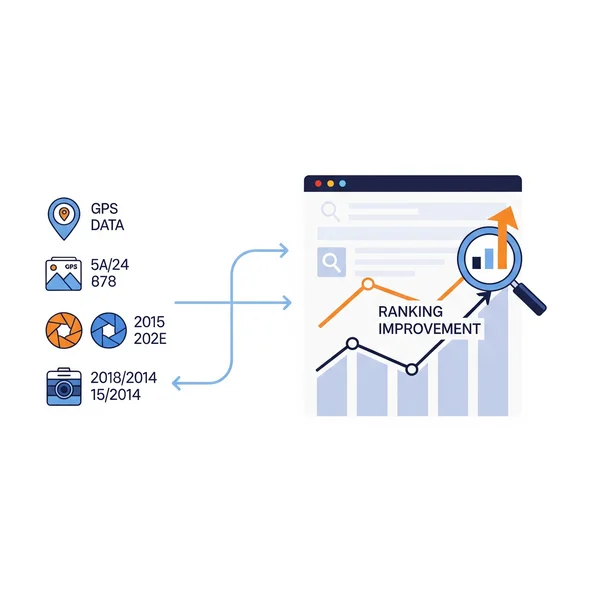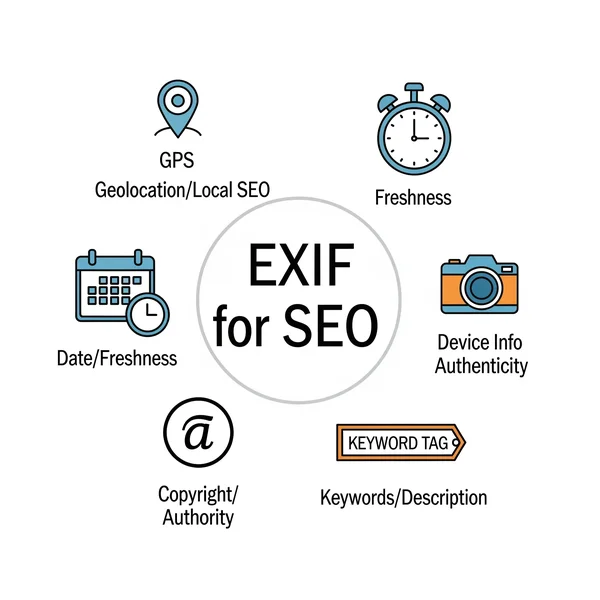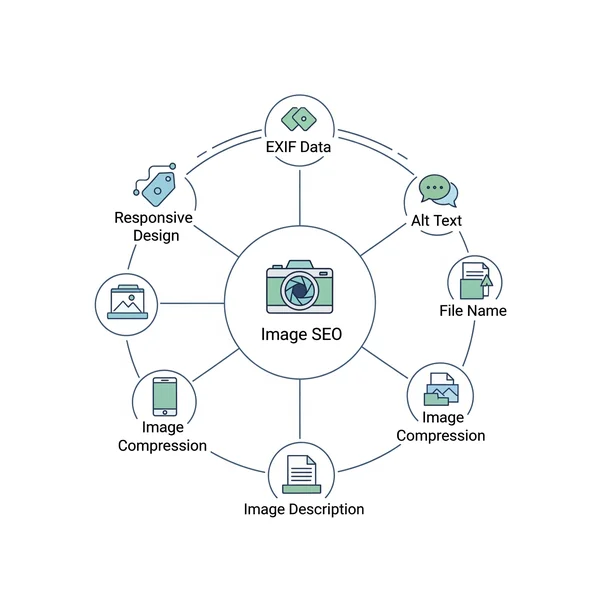EXIF Data and SEO: Boost Your Website Ranking
In the ever-competitive digital landscape, every edge in search engine optimization (SEO) counts. While content and backlinks often take center stage, image optimization is a crucial, yet sometimes overlooked, component. But did you know that the EXIF data embedded in your images could play a role in your search engine ranking? This article explores the connection between EXIF data and SEO, providing SEO tips on how metadata optimization can potentially help your website climb higher. How does EXIF affect SEO? Let's delve into the details. For tools that can help you manage this data, visit our EXIF data resource center.
What is Image SEO and Why Does it Matter?
Before we focus specifically on EXIF data SEO, it's important to understand the broader concept of image SEO. Image optimization involves a set of practices aimed at making your website's images more discoverable and understandable by search engines. Why is this important? Properly optimized images can:
- Drive significant traffic from image search results (like Google Images).
- Improve page loading speed (a key ranking factor).
- Enhance user experience.
- Increase the overall relevance and authority of your content in the eyes of search engines, contributing to a better search engine ranking.
The Role of Metadata in Image Optimization
Metadata provides context about your images to search engines, which cannot "see" an image the way humans do. Effective metadata optimization is fundamental to good image SEO.
Alt Text: The SEO Cornerstone
Alternative text (alt text) describes an image for search engines and for users who cannot see it (e.g., due to visual impairment or slow connections). It's a primary ranking factor for images.
File Names: Descriptive and Keyword-Rich
Using descriptive, keyword-rich file names (e.g., red-sports-car.jpg instead of IMG_1234.jpg) helps search engines understand the image content.
Captions and Surrounding Text
The text immediately surrounding an image, including captions, provides further context and relevance signals.
And Now, EXIF Data...
Beyond these well-known factors, the EXIF data embedded within the image file itself can offer additional contextual clues, leading us to the realm of EXIF data SEO.

EXIF Data: The Hidden Gem for SEO?
So, what exactly is the role of EXIF data in SEO? While search engines like Google are often coy about the exact weight of every ranking signal, they have indicated that they can read and may use EXIF data to better understand images and their context. This information, often automatically generated by cameras and smartphones, can include a wealth of details. The idea behind photo metadata SEO is that this data can subtly contribute to how search engines perceive your image's relevance and authenticity.
Key EXIF Data Fields That Can Influence SEO
Not all EXIF fields are created equal when it comes to potential SEO impact. Here are some key pieces of photo metadata SEO to consider:
Geolocation Data (GPS Coordinates)
If your image has embedded GPS coordinates, it can signal to search engines the geographical relevance of the image and the surrounding content. This can be particularly valuable for local SEO efforts – for example, a photo of a local landmark with accurate geotags.
Creation Date and Time
The date and time an image was taken (and potentially modified) might be used by search engines to assess the "freshness" of visual content or its relevance to time-sensitive events.
Camera and Lens Information
While less direct, information about the camera and lens used could, in theory, be a minor signal for image quality or authenticity, especially in photography-centric niches.
Copyright and Author Information
Embedding copyright and author information in EXIF data can help establish ownership and authority, which are positive signals for content credibility. This is a good SEO tip for content creators.
Keywords and Descriptions
Some EXIF fields allow for descriptions or keywords. If populated accurately and without stuffing, this directly tells search engines what the image is about, aiding metadata optimization.

How to Optimize EXIF Data for Better Search Engine Ranking
If you want to leverage EXIF data for SEO, here are some actionable SEO tips:
Ensuring Key EXIF Fields are Populated and Accurate
Use an EXIF editor to ensure relevant fields like geolocation (if applicable and desired for privacy), author, and copyright are correctly filled. Don't leave valuable metadata fields empty if they can add context.
Strategic Use of Geotags for Local SEO
For businesses or content focused on specific locations, ensure your images have accurate geotags. This reinforces your local relevance to search engines.
Maintaining Copyright Information for Authority
Consistently add your copyright information. This helps protect your work and can subtly signal content ownership and E-E-A-T (Experience, Expertise, Authoritativeness, Trustworthiness) to search engines.
Caution: Avoid Keyword Stuffing in EXIF Data
Just like with any other SEO practice, stuffing keywords into EXIF fields is a bad idea and could be seen as spammy. Keep descriptions natural and relevant.
Tools for Viewing and Editing EXIF Data for SEO
To implement these metadata optimization strategies, you'll need tools to view and edit EXIF data. Many desktop applications and online services, including our platform's EXIF tools, can help you manage this information effectively.
Does Google Actually Use All EXIF Data for Ranking? Debunking Myths
It's important to maintain a realistic perspective. While Google can read EXIF data, the direct impact of every single EXIF field on search engine ranking is debatable and likely varies. Google's official statements are often general, acknowledging they use information available to understand images better. Most SEO experts agree that while elements like GPS data might have a more discernible impact (especially for local search), other fields like camera model are likely very minor signals, if at all. EXIF data SEO should be seen as one part of a comprehensive image optimization strategy, not a silver bullet.
Beyond EXIF: Holistic Image Optimization Strategies
Remember, EXIF data SEO is just one piece of the puzzle. For truly effective image optimization, you must also focus on:
- Image Compression: Reducing file size without sacrificing too much quality for faster loading.
- Responsive Images: Ensuring images adapt to different screen sizes.
- Image Sitemaps: Helping search engines discover all your image content.
- Compelling Alt Text and File Names: As discussed earlier, these are crucial.
- Lazy Loading: Loading images only when they enter the viewport.
A holistic approach to optimize images for search engines will always yield the best results.

Your Questions on EXIF Data and SEO Answered
Should I remove EXIF data for SEO purposes?
Generally, no. If the EXIF data is accurate and contains useful information (like relevant geotags or copyright info), it can be beneficial. Only remove EXIF data if it contains sensitive private information or is grossly inaccurate. Strategic metadata optimization is about refining, not just removing.
How much impact does EXIF data really have on my search engine ranking?
The exact impact is hard to quantify and is likely less significant than factors like alt text, image quality, and page relevance. However, in a competitive landscape, even small advantages from good EXIF data SEO can contribute. Think of it as a supporting signal.
Can I add keywords directly into EXIF data for SEO?
Some EXIF fields (like "ImageDescription" or "UserComment") can technically hold keywords. However, avoid stuffing. Use them to provide natural, descriptive information. Search engines are smart enough to detect unnatural keyword usage. This is a key point in photo metadata SEO.
What are the best tools for metadata optimization including EXIF?
For viewing and editing EXIF data, desktop tools like ExifTool (command-line) or Adobe Bridge are powerful. For convenient online access, our EXIF management tools offer features to help with your metadata optimization efforts.
Integrating EXIF Data into Your SEO Toolkit
While EXIF data might not be the single most powerful factor in your search engine ranking, it's an often-underutilized aspect of image optimization. By strategically managing and optimizing your photo metadata SEO, you provide search engines with richer contextual information, potentially giving your content a subtle edge. Incorporate thoughtful EXIF data SEO practices and metadata optimization into your broader SEO strategy to ensure all elements of your website are working together to achieve higher visibility.